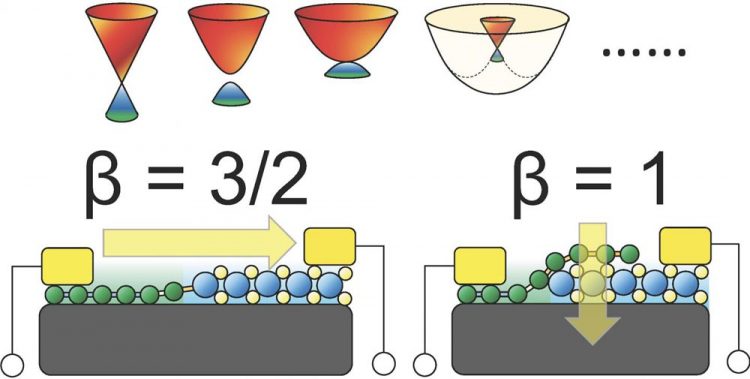SUTD researchers resolve a major mystery in 2D material electronics

Schematic drawing of a 2D-material-based lateral (left) and vertical (right) Schottky diode. For broad classes of 2D materials, the current-temperature relation can be universally described by a scaling exponent of 3/2 and 1, respectively, for lateral and vertical Schottky diodes. Credit: Singapore University of Technology and Design
The understanding of 2D material-based Schottky diode is, however, plagued by multiple mysteries. Several theoretical models have co-existed in the literatures and a model is often selected a priori without rigorous justifications. It is not uncommon to see a model, whose underlying physics fundamentally contradicts with the physical properties of 2D materials, being deployed to analyse a 2D material Schottky diode.
Reporting in Physical Review Letters, researchers from the Singapore University of Technology and Design (SUTD) have made a major step forward in resolving the mysteries surrounding 2D material Schottky diode. By employing a rigorous theoretical analysis, they developed a new theory to describe different variants of 2D-material-based Schottky diodes under a unifying framework. The new theory lays down a foundation that helps to unite prior contrasting models, thus resolving a major confusion in 2D material electronics.
“A particularly remarkable finding is that the electrical current flowing across a 2D material Schottky diode follows a one-size-fits-all universal scaling law for many types of 2D materials,” said first-author Dr. Yee Sin Ang from SUTD.
Universal scaling law is highly valuable in physics since it provides a practical “Swiss knife” for uncovering the inner workings of a physical system. Universal scaling law has appeared in many branches of physics, such as semiconductor, superconductor, fluid dynamics, mechanical fractures, and even in complex systems such as animal life span, election results, transportation and city growth.
The universal scaling law discovered by SUTD researchers dictates how electrical current varies with temperature and is widely applicable to broad classes of 2D systems including semiconductor quantum well, graphene, silicene, germanene, stanene, transition metal dichalcogenides and the thin-films of topological solids.
“The simple mathematical form of the scaling law is particularly useful for applied scientists and engineers in developing novel 2D material electronics,” said co-author Prof. Hui Ying Yang from SUTD.
The scaling laws discovered by SUTD researchers provide a simple tool for the extraction of Schottky barrier height – a physical quantity critically important for performance optimisation of 2D material electronics.
“The new theory has far reaching impact in solid state physics,” said co-author and principal investigator of this research, Prof. Lay Kee Ang from SUTD, “It signals the breakdown of classic diode equation widely used for traditional materials over the past 60 years, and shall improve our understanding on how to design better 2D material electronics.”
Media Contact
More Information:
http://dx.doi.org/10.1103/PhysRevLett.121.056802All latest news from the category: Materials Sciences
Materials management deals with the research, development, manufacturing and processing of raw and industrial materials. Key aspects here are biological and medical issues, which play an increasingly important role in this field.
innovations-report offers in-depth articles related to the development and application of materials and the structure and properties of new materials.
Newest articles

Sea slugs inspire highly stretchable biomedical sensor
USC Viterbi School of Engineering researcher Hangbo Zhao presents findings on highly stretchable and customizable microneedles for application in fields including neuroscience, tissue engineering, and wearable bioelectronics. The revolution in…

Twisting and binding matter waves with photons in a cavity
Precisely measuring the energy states of individual atoms has been a historical challenge for physicists due to atomic recoil. When an atom interacts with a photon, the atom “recoils” in…

Nanotubes, nanoparticles, and antibodies detect tiny amounts of fentanyl
New sensor is six orders of magnitude more sensitive than the next best thing. A research team at Pitt led by Alexander Star, a chemistry professor in the Kenneth P. Dietrich…





















